HALF PRICE SALE ON EVERYTHING ENDS ON FRIDAY
NEW SEASON BARE ROOTS AT 50% OFF LAST SEASONS PRICES – ENDS 31 JULY
***TODAY ONLY – GET AN EXTRA 10% OFF SALE PRICES WITH CODE FLASH10***
Menu
HALF PRICE SALE ON EVERYTHING ENDS ON FRIDAY
NEW SEASON BARE ROOTS AT 50% OFF LAST SEASONS PRICES – ENDS 31 JULY
***TODAY ONLY – GET AN EXTRA 10% OFF SALE PRICES WITH CODE FLASH10***
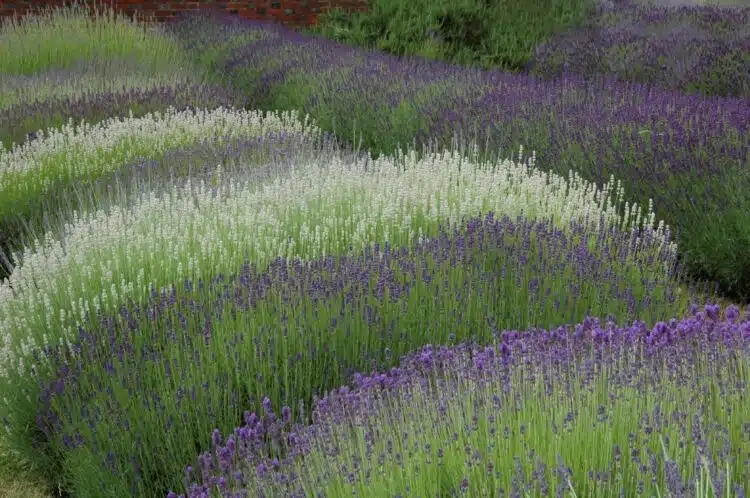 https://www.hopesgrovenurseries.co.uk/wp-content/uploads/2024/02/english-lavenders-750x498.jpg
LAVANDULA 'MUNSTEAD'
https://www.hopesgrovenurseries.co.uk/wp-content/uploads/2024/02/english-lavenders-750x498.jpg
LAVANDULA 'MUNSTEAD'
One of the iconic plants of high summer is lavender, a sun-lover with shimmering silvery foliage and nectar-rich flowers in shades of purple, lavender and blue. Once the temperatures rise, a sweet lavender aroma is released from the oily coating on the foliage and I find myself frisking the leaves and taking a deep breath during my habitual midday stroll round the garden. Pungent plants enjoy basking in the midday sun – almost as much as I do. They have their own built-in sunscreen.
Lavender’s soothing and antiseptic qualities have been appreciated in British gardens for centuries. Lavender posies were carried in Elizabethan times, to ward off the stench of high summer. The oil was mixed with bees wax and lavished on oak furniture in a bid to stop gnawing wood beetles. It was strewn on floors, to fragrance the air, and sandwiched between clean bedlinen. And it was added to sweet concoctions, including conserves and shortbread.
Even before then, Roman exiles stationed in the chilly UK fragranced their bath water with sprigs of relaxing lavender. And it’s still the herb of cleanliness and calm today: my night-time regime ends with locally made lavender hand cream – especially after a long day in the garden. My local farmers apply it too, because their hands get chafed and cracked.
Lavenders, or Lavandula to use their Latin name, are mostly woody subshrubs and they vary in hardiness and this affects their pruning regime and their lifespan. The most versatile, long-lived and hardiest is English lavender, or L. angustifolia. The foliage is narrow and needle-like and the blunt-tipped flower spikes, which generally appear in June, are roughly an inch in length. The flowerheads of this lavender don’t taper at the far end, or bear a tuft of jaunty petals at the top. Think guardsman’s busby.
English lavender reaches a foot or so in height, so it’s the go-to lavender hedging for rose beds, summer borders, or potagers. It’s the hardiest and the foliage should he trimmed back into base in late August, so that the new growth gets established before harsh weather arrives. If this regime is followed every year, English lavender will give you 20 years of joy.
If it’s not pruned hard in late-August, you’ll end up with a woody, leggy plant that’s ikely to succumb in winter. If you’ve inherited an old, unkempt lavender hedge, I urge you to adopt the ‘will it, won’t it’ approach. Cut back one half hard and leave the other half. The pruned side should regenerate. In which case cut the other side back a year later. If it doesn’t respond, it’s time to get the spade out and start again.
English lavender mixes well with a summer palette of perennials, bulbs and roses whether it’s peonies, penstemons or campanulas. The pink David Austen rose ‘Wildeve’ is a favourite of mine. Lavender is also an excellent flower to pick and dry, but this must be done when the flowers are freshly opened. The second week of Wimbledon is the optimum time. Hang small bunches of stems upside down in a dark, airy place. The richer colours look more effective dried, than the paler ones. If you cut too late in the season, the flowers will drop away from the stem. Then it will be lavender bags all round.
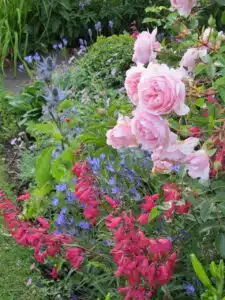
You can Chelsea chop English lavender and cut it back by a third in the second half of May, a practice that was carried out at the National Trust’s Mottisfont in Hampshire. This delays the flowers until after the roses have finished their first flush. The lavender plugs the gap before the second flush.
The famous lady gardener, Gertrude Jekyll (1843 -1931), gardened at Munstead Wood in West Surrey. The English lavender named after her garden is a soft, muted violet and the foliage is a deeper grey than most. The origin is unknown, but Gertrude Jekyll’s painterly eye admired the muted colour. Her plant was included in Barr’s nursery catalogue of 1902 under the name of New Dwarf Dark Blue, before being named ‘Munstead’.
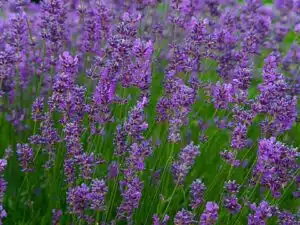
‘Hidcote’, the other choice for a low and upright hedge, has vibrant purple flowers and very aromatic grey-green leaves. It’s really eye-catching in June and it makes a superb hedge too. It may be named after the National Trust’s Hidcote Manor in Gloucestershire, but it has French connections. Major Lawrence Johnston (1871 -1958) owned Hidcote Manor until he died. He hated British winters. Well, don’t we all! This man of means took himself off the south of France during the winter and one year, during the 1920s, he came back with this vibrant lavender. Cuttings were passed to the well-connected nursery man Thomas Carlile, owner the Loddon Nursery near Twyford in Berkshire.
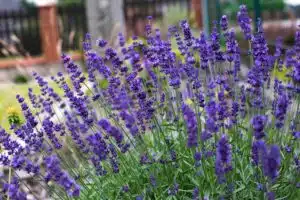
‘Hidcote’ became widely grown and known after 1949 and one of its greatest admirers was Vita Sackville-West, the creator of Sissinghurst Castle Garden in Kent. She visited Hidcote and saw it tumbling out of a dry wall in 1949 and wrote about its deep-purple flowers.
There’s another more-flowing option, the lavandin. This flowers in late summer and goes on into early autumn, because it’s sterile. It can’t set any seeds, so on it goes on performing and looking good for a long time. It will follow on from English lavender, so you could get months of aromatic fragrance if you grow both.
The stems splay outwards, radiating from the low mound of foliage. Each long stem is topped by a slender tapering flower spike that can be two inches in length from tip to toe – earning the name spike lavender. These lavandins form a dome of flower and, although they need more space, they’re excellent edgers because they add waves of colour in an informal way. I love to see them erupting in paving because the fountain of foliage is so exuberant and generous, or framing a set of steps. You can’t help but brush past them and get that sweet waft.
Lavandins are naturally occurring hybrids between English lavender and a less than hardy, woolly-leaved Spanish lavender named L. latifolia. They are called L. x intermedia and they do have added hybrid vigour. They aren’t quite as hardy as English Lavenders so they need a gentler pruning regime. Trim them back in September, leaving most of the leafy growth intact and then trim them again in spring, once growth breaks, should they need it.
Lavandins are the aromatic beauties you see creating furrows of colour in the fields of Provence. They’re grown for their abundance of camphor-like oil, because their slender flower spikes are said to yield ten times more oil than other lavenders. The most widely grown is ‘Grosso’ and it’s easy to identify because the light-green foliage is really distinctive, as are the violet flowers. Most lavandins have greyer foliage.
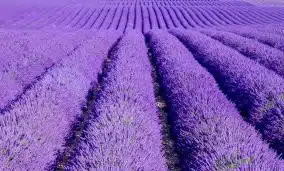
The first plants were discovered by farmer M. Pierre Grosso in 1972, in his fields at Goult near Apt in the Luberon district of France. He had been growing lavandins since 1931, so he knew that they were distinctly different. M. Grosso took cuttings and soon realised that the plants were both vigorous and hardy. The oil from the flowers was more pungent, but the yield was higher. By the 1980s 55% of the lavandin crop consisted of ‘Grosso’. Today, it’s the most widely grown field variety for lavender oil in the world, so thank you M. Grosso!
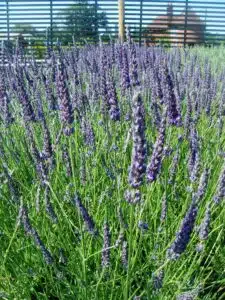
Most of Grosso’s oil is used in potpourri or in detergents, but the bright-purple flowers dry really well and it’s a robust performer in the garden setting. It’s more colourful than most lavandins and it’s slightly later into flower, so it always looks tremendous at the end of August.
‘Provence Blue’, syn ‘Provence’, is a softer affair with greyer green foliage and soft, lavender-blue flower spikes. It’s extremely floriferous and the shape is more compact, although still rounded. This has proved extremely hardy and it’s thought to have been raised in Canada in the 1950s, despite the French-sounding name.
‘Vera’, previously known as ‘Dutch’ lavender, is another from the 1920s or even earlier perhaps. The foliage is distinct particularly in winter, because the highly aromatic leaves are broader and lighter in colourr. This one probably has the palest foliage and its shines in winter light. The slender flower spikes are blue-mauve and it forms a dense bush, so it makes an excellent rounded hedge. Trim back in early autumn.
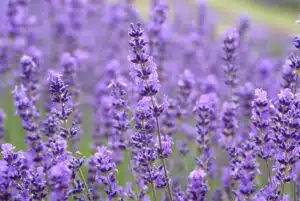
Lavenders are very pollinator friendly, because their nectar contains a high proportion of sugars. Their flowers will sustain bees and butterflies. They are also very drought-tolerant, once a deep root system is established. This will take a season or two, so they will need watering in the growing season, after they’ve been planted. They need sunny, well-drained positions and they tolerate poorer soil, so don’t lavish them with plant food. Just enjoy them, in pots, or along paths, in paving or planted in strategic sunny positions. Just inhale and relax!
Many of our customers buy topiary plants (and hedging plants) to grow in containers, one frequently asked question is how large does the pot that I plant them into need to be?
Expert horticultural advice on the merits and pitfalls of planting bare root yews, and how to get the best from them.
Pleached trees are a garden-design favourite, because they provide an instant leafy screen that looks stylish as soon as it’s planted. They offer privacy for you and they help to muffle noise and that’s becoming more important in our busy world. They provide a living screen that’s far more eco-friendly than a stark wooden fence…